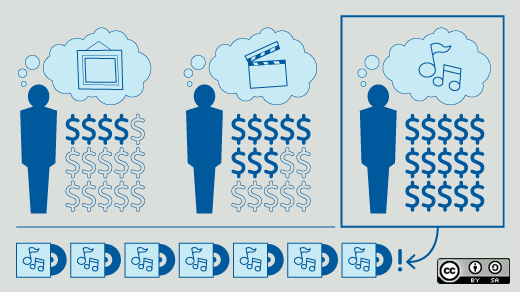Karen Borchert gave a talk at the All Things Open conference (October 22 and 23) about how 'open' changes products. I am a Community Moderator for Opensource.com and covered the talks I attended at the conference this year. I will be sharing my recap of the presentations on the site over the next several weeks.
The open product conundrum is about how there is a thing that happens when we think about creating products in an open world. In order to understand this we must first understand what a product is. A product is a good, idea, method, information, or service that we want to distribute. In open source, we think differently about this. We think more about tools and toolkits instead of packages and products because these things are more conducive to contribution and extension.
'Open' products work a bit more like Ikea—you have all the right pieces and instructions but you have to make something out of it—a table or chair or whatever it may be. Ikea products are toolkits to make things. When we’re talking about software most buyers are thinking about what they get out of the box, so a toolkit is not a product to our consumers.
Open Atrium is a product that Phase2 produces and people say often that it is like "an intranet in a box." But, in reality it’s a toolkit. People use it a lot of different ways—some do what you’d expect them to do, others use it completely differently. This is the great thing about open source, but this causes a problem for the open source community. Karen says, "The very thing that makes open source awesome is what makes our product hard to define."
Defining a product in the open arena is simple. "Making an open source product is about doing what’s needed to start solving a customer problem on day 1."
Karen asks: Why are we even going down this road? Why are we creating products? Making something that is useable out of the box is what people are demanding. They also provide a different opportunity for revenue and profit.
This comes down to three things:
- Understanding the value
- Understanding the market
- Understanding your business model
A lesson: If you have an apple, you have all you need to grow your own apples, but you’re likely not going to do that. You’d rather (or most people would rather) leave that to the expert, the farmer. Just because anyone can take the toolkit and build whatever they want with it does not mean that they will.
Markets are hard for us in open source because we have two markets: one that gives the product credibility and one that makes money. And, often these aren’t the same market. Most of the time the community isn’t paying you for the product, there are usually other developers or people using it to sell to their clients. You need this market because you do benefit from it even if it’s not financially. You also need to work for the people who will pay you for products and services. You have to invest in both markets to help your product succeed.
Business models include the ability to have two licenses which means two versions of the product. There is a model around paid plugins or themes to enhance a product. And sometimes you see services built around the product. People buy many things in open products: themes, hosting, training, content, etc. What about services? Services are important in any business model. You don’t have to deliver a completely custom set of services every time, and it’s not less of a product because it’s centered around services.
Questions people ask
Is it going to be expensive to deal with an open source product?
Not necessarily, but it’s not going to be free. You need to plan and budget properly and invest properly.
Am I going to make money on my product this year?
Maybe, but you shouldn’t count on it. Don’t bet the farm on your product business until you’ve tested the market.
Everyone charges $10/mo for this, so I’m just going to charge that. Is that cool?
Nope! You need to charge what the product is worth and what people will pay for it and what you can afford to sell it for. Think about your ROI.
I’m not sure we want to be a products company.
It’s very hard to be a product company without buy-in. A lot of service companies ask this. Consider instead a pilot program and set a budget to test out this new model. Write a business plan.
Originally posted on Nicole's blog What I Learned Today as ATO2014: How 'Open' Changes Products. Reposted via Creative Commons.






Comments are closed.